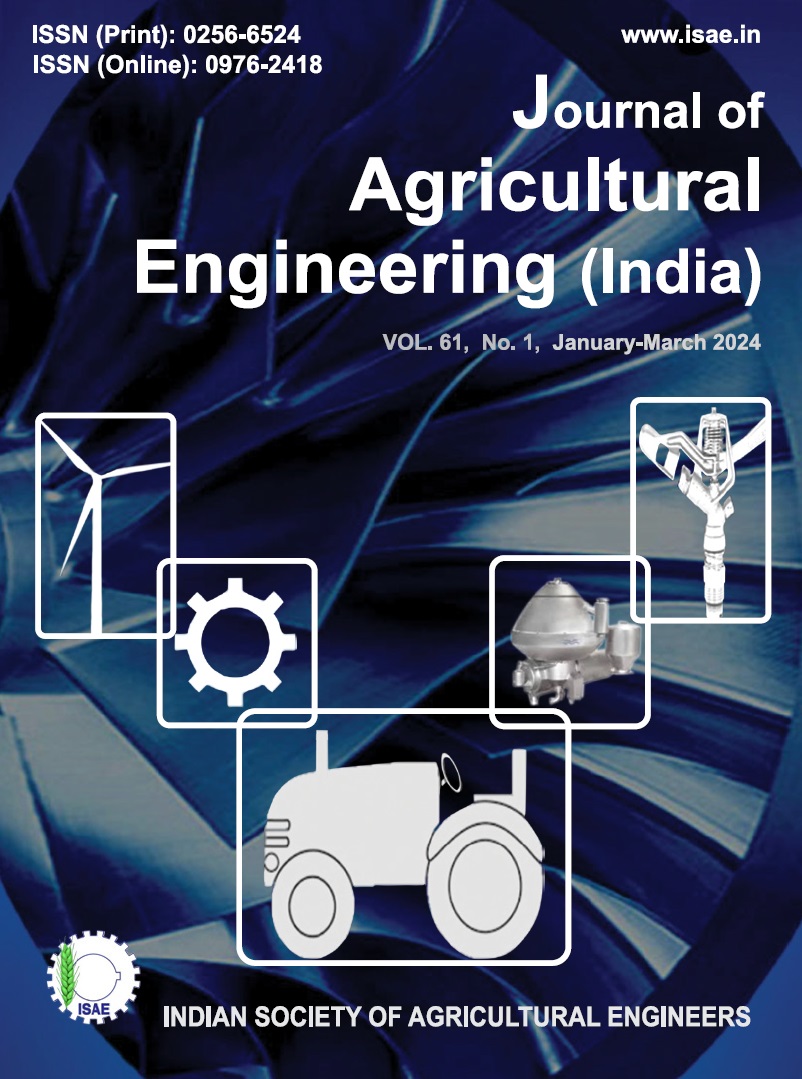Development of an Electronic Actuating Control Mechanism to Operate a Remotely Controlled 2-Wheel Rice Transplanter
DOI:
https://doi.org/10.52151/jae2024611.1830Keywords:
Human drudgery, Paddy transplanter, performance evaluation, remote-controlled paddy transplanterAbstract
Mechanical transplanters are adopted to reduce human drudgery in manual transplanting. Different types of manual and self-propelled paddy transplanters are commercially available. The human involvement is higher for operating a 2-wheel paddy transplanter operator has to walk 10-22 km behind the machine in a day in puddled field conditions under high temperature (38-440 C) and humid conditions (70-80% RH) in summer. Besides that, the operator has to walk within the 30 cm row width, which causes chafing between the thighs of an operator. To reduce the physical and physiological workload of an operator, an integrated control lever actuating mechanism with gear motors was developed to operate a 2-wheel paddy transplanter remotely. The inductive proximity sensors (SN04-N distance detector) were used to control the crank rotation position of the gear motors, motor drives (BTS 7960), and microcontroller (STM32F4) was used to connect with the auto-driver kit to control the motor mechanism and sensors. The auto-driver kit consisted of a variety of accessories, a physical programmable circuit board, and software, that runs on a PC, used to write and upload computer code as a simplified version of C++ to the physical board. Although the initial cost of the machine with the developed system has been increased up to 28%, but at the same time the effective field capacity has been increased from 0.158 ± 0.02 ha h-1 to 0.175 ± 0.04, resulting the area covered per day and per year has also increased up to 11%. With the development of remotely controlled system, the labor requirement has been reduced from 20± 1 to 13± 1 man h ha-1, which results reduction up to 40%. Moreover, the human fatigue in terms of physical and physiological work load involved while walking behind the transplanter has been eliminated at much extent. As compared to the existing walk-behind type paddy transplanter, the net profit with the developed system rise up to 18.50 to 26.61 % per year and a boost of 34.10 to 51.63% in benefit-cost ratio. Field evaluation of a developed remote-controlled system for a two-wheel rice transplanter would be viable, reducing fatigue among machine operators/farm workers while increasing work productivity and safety.
References
Inthiyaz M; Mishra J; Mohanty SK; Pradhan PL; Behera D. 2021. Ergonomics of Manual Transplanting Operations with Female Workers in Eastern India. J Ergonomics, 11, 1-6.
Karthik G; Srinivas I; Ravikant Adake V; Edukondalu L; Jha A. 2018. Development and Performance Evaluation of Manually Operated Two Row Paddy Transplanter. The Andhra Agric.J. 65,69-76.
Lohan S K; Narang M K; Javed M; Kumar V; Majumder A; Raghuvirsinh P. 2022. Optimization and evaluation of machine–field parameters of remotely controlled two-wheel paddy transplanter. Journal of Field Robotics, 39, 984-998. https://doi.org/10.1002/rob.22080
Lohan S K; Narang M K; Singh M; Khadatkar A; Karkee M. 2021. Actuating force required for operating various controls of a walk-behind type paddy transplanter leading to development of a remotely operated system. Journal of Agricultural Safety and Health, 27, 87-103. https://doi.org/10.13031/JASH.14186
Lohan S K; Narang M K; Singh M; Singh D, Sidhu H S; Singh S; Dixit A K; Karkee M. 2022. Design and development of remote-control system for two-wheel paddy transplanter. Journal of Field Robotics, 39,177-187. https://doi.org/10.1002/rob.22045
Mahal J; Singh A; Manes G; Narang M; Dixit A; Singh B. 2012. Status of Use of Paddy Transplanters in Punjab. Agricultural Engineering Today, 36, 6–11.
Manes G; Dixit A; Singh A; Mahal J; Mahajan G. 2013. Feasibility of Mechanical Transplanter for Paddy Transplanting in Punjab. Agricultural Mechanization in Asia, Africa & Latin America , 44, 14–17.
Samal S K; Mishra J N; Pradhan R R; Pradhan P L; Mohanty S K. 2020. Comparison of Field Performance of Different Paddy Transplanters Available in Odisha. International Journal of Current Microbiology and Applied Sciences, 9, 992–1000. https://doi.org/10.20546/ijcmas.2020.903.117
Sharma S; Manhas S S; Sharma R M; Lohan S K. 2014. Potential of variable rate application technology in India. AMA, Agricultural Mechanization in Asia, Africa and Latin America, 45,74-89














